Growing your own nutrient-rich vegetables is rewarding. It gives you fresh produce right in your backyard. I’ve spent years mastering vegetable gardening techniques and I’m eager to share them with you.
Using sustainable, organic methods can turn your garden into a food paradise. This guide is for everyone, from beginners to seasoned gardeners. It covers everything from soil prep to harvesting your crops.
Key Takeaways
- Learn the basics of soil preparation for optimal vegetable growth.
- Discover effective techniques for maintaining a healthy vegetable garden.
- Understand the importance of sustainable gardening practices.
- Explore tips for maximizing the nutritional content of your vegetables.
- Find out how to enjoy a bountiful harvest using organic methods.
The Joy and Benefits of Growing Your Own Food
Growing a vegetable garden is more than just getting fresh food. It connects you deeply with nature. I’ve learned that it’s not just about the food. It’s about the health benefits and helping the planet too.
Health and Nutritional Advantages of Home-Grown Vegetables
Vegetables from your garden are packed with more nutrients than store-bought ones. They’re picked at the best time, so they’re full of vitamins and minerals. Studies show that these veggies have more nutrients than those from the store.
Nutritional Comparison: Homegrown veggies have more nutrients than store-bought ones.
| Vegetable | Homegrown Nutrient Level | Store-bought Nutrient Level |
|---|---|---|
| Tomatoes | High in vitamin C and lycopene | Lower levels of vitamin C and lycopene |
| Carrots | Rich in beta-carotene | Less beta-carotene due to longer storage |
| Spinach | Higher iron content | Lower iron content |
Environmental Impact and Sustainability Benefits
Growing your own food helps the planet. It cuts down on food miles, packaging, and carbon emissions from big farms. Using organic vegetable gardening methods makes it even better for the environment.
By following the best ways to grow veggies, like rotating crops and saving water, you make a garden that’s good for you and the earth.
Planning Your Vegetable Garden for Success
Before you start planting, it’s important to plan your vegetable garden carefully. You need to know your growing conditions, pick the best spot, and choose vegetables that will do well.
Assessing Your Growing Space and Climate
First, look at your garden space and local weather. Think about how much sunlight it gets, the soil type, and the yearly temperature. Most veggies need 6-8 hours of direct sunlight. Knowing your climate zone is key because it tells you which veggies to grow and when.
Choosing the Right Location for Maximum Sunlight
Finding a spot that gets lots of sunlight is key for most veggies. Watch your garden during the day to find sunny spots. While many veggies need full sun, some greens can handle partial shade. Watching sun patterns helps plan your garden layout.
Selecting Vegetables That Thrive in Your Region
Picking the right veggies for your climate is essential for a good harvest. You need to know the difference between cool-season and warm-season crops. Also, choose between heirloom and hybrid varieties.
Cool-Season vs. Warm-Season Crops
Cool-season crops like lettuce and broccoli do well in cooler weather. Warm-season crops like tomatoes grow best in summer heat. Choosing the right season for your crops helps them grow well.
Heirloom vs. Hybrid Varieties
Heirloom veggies have unique tastes and genetic variety. Hybrid varieties have better disease resistance and look the same. Knowing the benefits of each helps you choose wisely for your garden.
| Vegetable Type | Season | Characteristics |
|---|---|---|
| Lettuce, Spinach | Cool | Thrives in spring or fall |
| Tomatoes, Peppers | Warm | Requires summer heat |
| Heirloom Varieties | Varies | Unique flavors, genetic diversity |
| Hybrid Varieties | Varies | Disease resistance, uniformity |
How to Grow Healthy Vegetables: The Soil Foundation
The key to growing healthy, nutrient-rich vegetables lies in the soil. As any seasoned gardener knows, the quality of your soil directly impacts the health and productivity of your vegetable garden. In this section, we’ll explore the steps to create a soil foundation that supports optimal vegetable growth.
Testing and Understanding Your Soil Composition
Understanding your soil’s composition is the first step. This involves testing your soil to determine its texture, pH level, and nutrient content. You can use DIY soil testing kits for a basic analysis or opt for professional testing services for more detailed insights.
Different vegetables have different soil preferences. It’s important to know what your soil lacks and what it has in abundance. For instance, some vegetables thrive in slightly acidic soils, while others prefer more alkaline conditions.
Building Nutrient-Rich Soil for Vegetable Growth
Building nutrient-rich soil is an ongoing process that requires patience and dedication. One effective method is incorporating organic matter through composting. Compost enriches the soil with nutrients, improves its structure, and supports the soil’s ecosystem.
Other organic amendments like worm castings, leaf mold, and cover crops can also dramatically improve soil fertility and structure over time. These natural methods not only enhance soil health but also contribute to a more sustainable gardening practice.
| Soil Amendment | Nutrient Contribution | Impact on Soil Structure |
|---|---|---|
| Compost | Rich in N, P, K, and micronutrients | Improves soil porosity and water retention |
| Worm Castings | High in N, P, and beneficial microbes | Enhances soil aggregation and fertility |
| Leaf Mold | Rich in humus and micronutrients | Improves soil’s water-holding capacity |
The Role of Compost and Organic Matter
Compost is often considered the gardener’s gold because of its multifaceted benefits. It not only adds essential nutrients to the soil but also improves its structure, making it more conducive for root growth. Compost also supports beneficial microbial activity, which is key for nutrient cycling and overall soil health.
Incorporating organic matter like compost into your soil is a straightforward way to boost your vegetable garden’s productivity. It’s a natural, sustainable approach that fosters a healthy soil ecosystem, leading to healthier, more resilient plants.
Garden Design and Layout Strategies
A well-planned garden layout is key to successful vegetable gardening. It makes your garden look good and helps you grow more food with less work.
Creating an Efficient Garden Layout
Think about the size of plants and what they need to grow well. Companion planting is also important. It’s when you pair plants to help each other grow and fight pests. For instance, marigolds can keep nematodes away from tomatoes.
- Check how big plants will get to know how far apart to plant them.
- Look at what each plant needs, like sunlight and water.
- Use companion planting to help plants grow better and fight pests.
Raised Beds vs. In-Ground Planting
Raised beds are great because they drain well, warm up faster, and are easy to reach. But, planting in the ground can save money and is simpler to start. Think about what you need and what you can handle.
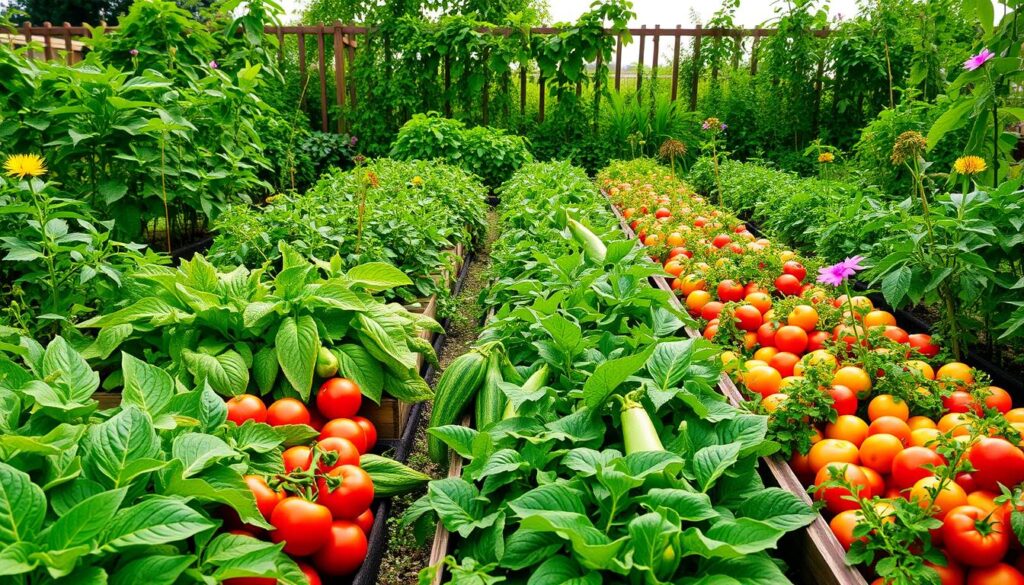
Container Gardening for Limited Spaces
If you don’t have much room, try container gardening. You can grow many vegetables in pots or tubs. Just pick the right size container, use good soil, and choose small varieties of vegetables.
- Choose containers that are at least 5-7 gallons for most vegetables.
- Use a potting mix that drains well to avoid soggy soil.
- Pick compact or dwarf varieties that are made for growing in containers.
Using these strategies, you can make a garden that’s both productive and fun. It will fit your space and meet your needs.
Essential Tools and Supplies for Vegetable Gardening
Reflecting on my years of gardening, I’ve learned that the right tools are key. The quality and fit of tools can make a big difference. It’s what turns a good garden into a great one.
Must-Have Tools for Planting and Maintenance
Some tools are a must for vegetable gardening. A quality trowel is needed for planting seeds and seedlings. A garden fork helps turn over the soil gently.
Pruners are for trimming plants, and a comfortable hoe is for weeding. Durable, ergonomic tools make gardening more fun and less tiring.
Other important tools include a garden rake for leveling soil and a measuring tape or garden marker for spacing. These tools are essential and used often during the growing season.
Quality Supplies That Make a Difference
There are also supplies that can greatly impact your garden’s success. Row covers protect against pests, and plant labels help you keep track of your plants. High-quality garden gloves protect your hands from thorns and dirt.
Irrigation supplies like soaker hoses and timers ensure plants get enough water. This is vital for their growth. Investing in these supplies can make your garden more productive and sustainable.
Planting Techniques for Optimal Growth
Planting techniques are key to a healthy vegetable garden. The right methods can boost your vegetables’ growth and yield.
Starting Seeds Indoors vs. Direct Sowing
Deciding to start seeds indoors or directly sow them is a big choice. Starting seeds indoors is great for tomatoes, peppers, and eggplants. It gives them a head start.
Direct sowing is better for root vegetables and quick-growing greens. My setup includes adequate lighting, heat mats, and a careful hardening-off process. This helps seedlings adjust to outdoor conditions.
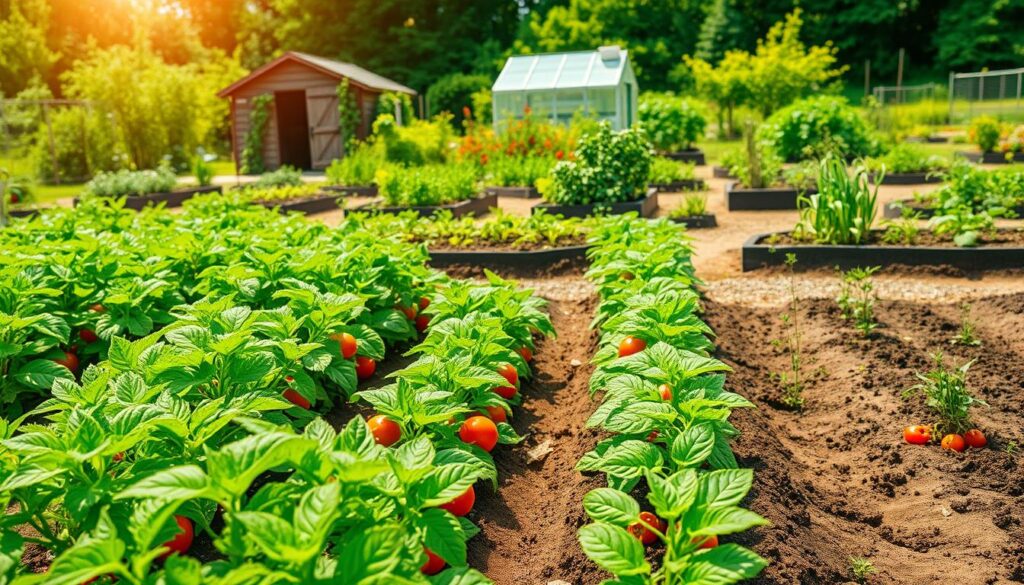
Proper Spacing and Depth Guidelines
Proper spacing is vital for plant health. It ensures good air circulation and less disease. Here are some guidelines for common vegetables:
| Vegetable | Spacing | Depth |
|---|---|---|
| Tomatoes | 18-24 inches | 1/4 inch |
| Lettuce | 4-6 inches | 1/8 inch |
| Carrots | 2-3 inches | 1/4 inch |
Companion Planting Strategies
Companion planting boosts growth and keeps pests away. Planting basil near tomatoes improves flavor and repels insects. Marigolds are great for deterring pests across the garden.
Beneficial Plant Combinations
- Basil and Tomatoes
- Marigolds and Carrots
- Nasturtiums and Cabbage
Plants to Keep Separated
Some plants do better apart. For example, fennel should not be near most vegetables. It can slow their growth.
Using these planting techniques will help your vegetable garden thrive. You’ll see better health and productivity from the start.
Sustainable Garden Practices
Embracing sustainable gardening has transformed my vegetable garden. I’ve seen big improvements in soil quality and garden health. Practices like crop rotation, succession planting, and cover crops have made a big difference.
Crop Rotation Principles
Crop rotation keeps soil nutrients balanced and breaks pest cycles. I follow a simple four-year rotation plan. For example, I rotate brassicas with solanaceae to keep the soil healthy.
Succession Planting for Continuous Harvests
Succession planting boosts my garden’s productivity. I plant quick-growing crops like radishes and lettuce every 2-3 weeks. This way, I always have fresh veggies to harvest.
Cover Crops and Green Manures
Cover crops enrich the soil during fallow periods. I use clover in summer and winter rye in fall. A gardening expert once said,
“Cover crops are a vital component of sustainable gardening, enriching soil fertility and structure.”
Vegetable Garden Irrigation Systems and Water Management
Good irrigation can really boost your vegetable garden’s yield and quality. It’s key to water plants right to keep them healthy and productive.
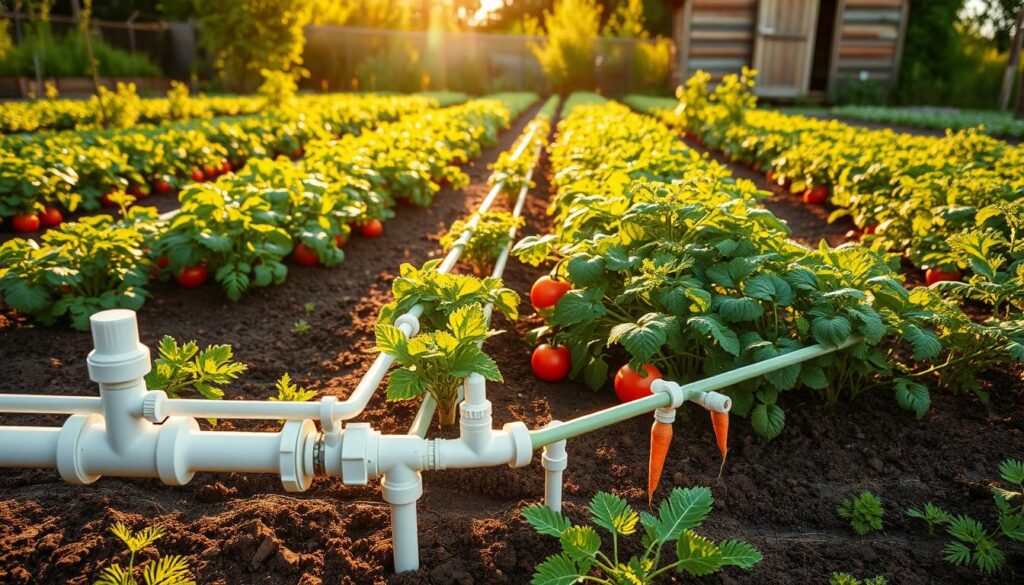
Determining Water Needs for Different Vegetables
Vegetables need different amounts of water. For example, tomatoes need deep, infrequent watering. Leafy greens like more steady moisture. Knowing this helps you water each part of your garden just right. Here’s a quick guide to water needs for some common veggies:
| Vegetable | Water Requirement |
|---|---|
| Tomatoes | Deep, infrequent watering |
| Leafy Greens | Consistent moisture |
| Carrots | Moderate, consistent watering |
Efficient Watering Techniques and Timing
Using smart watering methods helps save water and fights disease. Drip irrigation systems send water straight to roots, cutting down on evaporation and disease. I water my garden in the early morning. This lets plants dry before night, which helps avoid fungal issues.
Water Conservation Methods for Sustainable Gardening
For sustainable gardening, saving water is key. Methods like rainwater harvesting, mulching, and using soil amendments to hold water are great. Also, hydrozoning (grouping plants by water needs) and picking drought-tolerant varieties help save water too.
Organic Fertilization Strategies
The secret to a great organic vegetable garden is knowing how to fertilize well. Organic methods help plants grow strong and improve soil health for the future.
Nutrient Requirements for Vegetables
Vegetables need a mix of nutrients to thrive. The big three are nitrogen (N), phosphorus (P), and potassium (K). They help with leaves, roots, and overall health. Other nutrients like calcium and iron are important too.
Spotting signs of nutrient lack, like yellow leaves, helps gardeners fix their fertilizing plans.
Natural Fertilizers for Vegetable Gardens
Nature has many fertilizers for gardens. Compost tea is a liquid full of good microbes. Worm castings offer a balanced nutrient mix.
Special fertilizers like bone meal and kelp meal help with specific needs.
Timing and Techniques for Fertilizing
When and how you fertilize matters a lot. For example, adding nitrogen when tomatoes and corn fruit can increase yields. Foliar feeding gives nutrients directly to leaves, helping during key growth times.
Using these methods ensures your veggies get the right nutrients at the right time.
Pest Control in Vegetable Gardens
Pest management is key in organic vegetable gardening. We all face the challenge of pests ruining our gardens. The solution is to use a variety of strategies that keep the garden balanced.
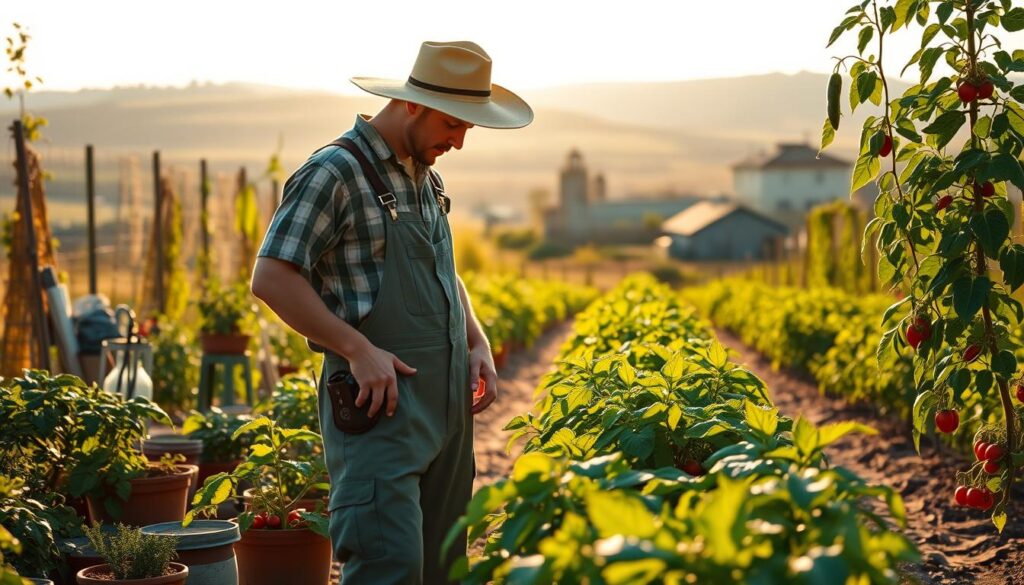
Identifying Common Garden Pests
First, we need to know what pests we’re dealing with. Common pests are aphids, cabbage worms, cucumber beetles, and squash bugs. Each pest damages plants in different ways. Knowing their habits helps us manage them better.
Natural Predators and Beneficial Insects
Encouraging natural predators and beneficial insects is a great way to control pests. Plants like dill, fennel, and cosmos attract helpful insects. These insects can control pests for us, reducing the need for other methods.
Organic Pest Control Solutions
When we need to act, there are organic solutions. These include homemade sprays and physical barriers that protect the environment.
Homemade Organic Sprays
Homemade sprays can fight many pests. Neem oil solution works against several pests. Garlic-pepper spray keeps soft-bodied insects away. Insecticidal soap is good for aphids and mites. It’s important to use these sprays correctly to protect both plants and beneficial insects.
Physical Barriers and Traps
Physical barriers and traps are also important. Row covers keep pests off plants. Copper tape stops slugs and snails. Diatomaceous earth controls slugs, snails, and insects with hard shells. Traps help catch and remove pests, preventing more damage.
Disease Prevention and Management
Keeping a vegetable garden healthy is more than just good soil and enough water. It also means being proactive about disease prevention. As a gardener, I’ve found that knowing common vegetable diseases and preventing them is key to a good harvest.
Common Vegetable Diseases and Their Symptoms
Vegetable gardens face many diseases, like early blight, powdery mildew, bacterial wilt, and mosaic viruses. Early blight on tomatoes shows as yellow halos on lower leaves. Powdery mildew on squash and cucurbits looks like a white, powdery coating on leaves. Spotting these signs early is vital for managing the disease well.
| Disease | Symptoms | Affected Vegetables |
|---|---|---|
| Early Blight | Yellow halos on lower leaves | Tomatoes, Potatoes |
| Powdery Mildew | White, powdery coating on foliage | Squash, Cucumbers, Melons |
| Bacterial Wilt | Wilting of plants without yellowing | Cucumbers, Squash, Tomatoes |
Preventative Measures for Plant Health
Preventing disease is always better than treating it after it starts. To keep your garden healthy, choose disease-resistant varieties when you can. Also, ensure good air circulation by spacing plants right, avoid overhead watering, and clean your tools well.
For organic disease control, try using compost tea or milk sprays. These introduce good microbes that fight off diseases like powdery mildew.
Vegetable Garden Maintenance Throughout the Growing Season
Keeping your vegetable garden in top shape is essential. Regular care ensures your plants grow strong and healthy. It also helps you get the most out of your harvest. By sticking to a routine, you can avoid many common problems.
Regular Monitoring and Care Routines
Checking your garden regularly is key. I inspect mine every week. I look for pests, check for nutrient needs, and see how wet the soil is. This way, I can catch issues early.
- Inspect plants for signs of pests or diseases
- Check soil moisture to determine watering needs
- Monitor new growth for nutrient deficiencies
Pruning and Training Techniques
Pruning and training are vital for your plants. For example, removing suckers from indeterminate tomatoes helps them grow better. It also makes them more productive. Pinching back basil makes it bushier and stops it from flowering.
Using trellises for cucumbers and pole beans saves space. It also keeps the fruits clean and free of dirt.
Weed Management Strategies
Weeds are a constant battle in the garden. Mulching is my main defense. I use straw, leaf mold, or even clover to keep weeds away. When weeds do pop up, I gently dig around them to stop them without harming my veggies.
By making these maintenance steps part of your routine, you’ll soon find caring for your garden becomes easy. This leads to healthier plants and more food for you.
Season Extension Techniques
Extending the growing season is a big win for gardeners. It lets you enjoy fresh produce all year. Simple techniques can make your garden more productive and keep you harvesting veggies even when it’s not peak season.
Cold Frames and Row Covers
Cold frames are great for early spring and late fall. They trap solar heat and protect plants from bad weather. You can make one from old windows. Just make sure it’s in the right spot to get lots of sunlight but not too hot.
Row covers add extra protection. They come in different weights for different needs. You can use them to keep insects away or to protect against frost.
- Lightweight row covers for insect protection
- Medium-weight covers for added frost protection
- Heavy-duty covers for extreme weather conditions
Greenhouses and Hoop Houses
Greenhouses are for serious gardeners. They let you control the environment with heat and ventilation. You can choose from glass, polycarbonate, or polyethylene, depending on your budget and needs.
Hoop houses are cheaper and easier to make. They use PVC pipes or metal covered with plastic. They give you a safe place to grow without the cost of a greenhouse.
Using these techniques, you can grow for longer and get more from your garden. Whether you choose cold frames, row covers, greenhouses, or hoop houses, the important thing is to try them out. See what works best for your climate and gardening dreams.
Harvesting for Maximum Flavor and Nutrition
The art of harvesting vegetables is all about timing. It’s not just about picking them; it’s about picking them at the right moment. This ensures you get the best flavor and nutrition.
Determining the Optimal Harvest Time
Each vegetable has its own best time to harvest. Snap beans are best when they’re thin and tender. Sweet corn is ready when its silks turn brown and the juice is milky.
Many vegetables are at their peak in the morning. This is the best time to harvest them.
- Check your vegetables regularly for readiness.
- Use the morning hours for harvesting most vegetables.
- Understand the specific harvest indicators for each type of vegetable.
Proper Harvesting Techniques
Harvesting the right way keeps your vegetables fresh and boosts yields. For example, cutting leafy greens right can make them grow more. Harvesting summer squash often makes it grow more too.
Using sharp tools like knives or garden shears helps avoid damaging the plants.
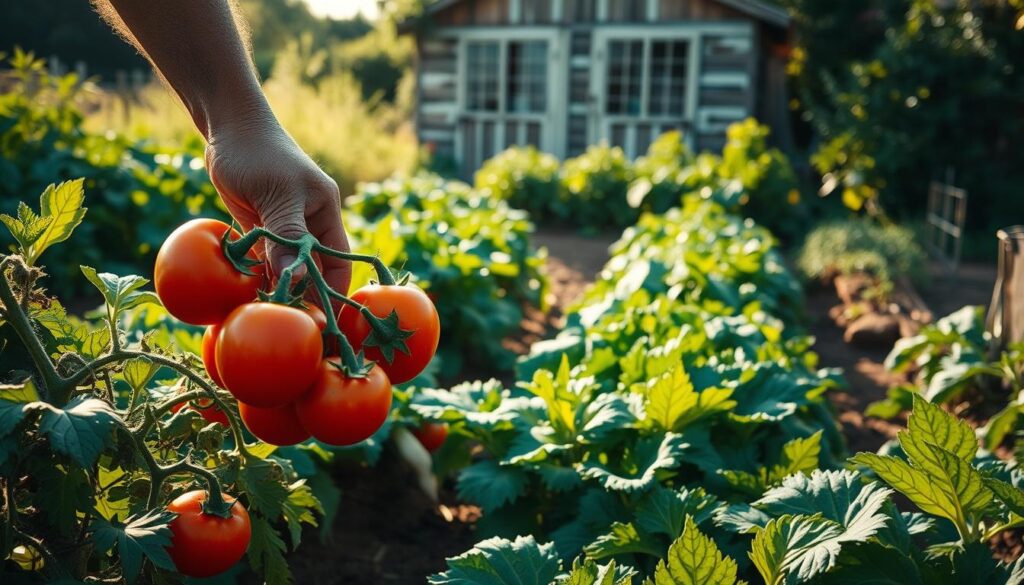
Storing and Preserving Your Harvest
Some vegetables can be stored for a long time. Techniques like curing winter squash in the sun make them sweeter and last longer. Each vegetable has its own storage needs.
For example, root vegetables like carrots need cool, humid places. Onions and garlic do better in warm, dry spots. Simple ways to preserve your harvest include fridge pickling, freezing, and drying herbs.
Key storage tips:
- Store vegetables in appropriate conditions based on their type.
- Use curing for vegetables like winter squash.
- Explore preservation methods to enjoy your harvest year-round.
Conclusion: Growing a Lifetime of Healthy Vegetables
Growing your own vegetables connects you to nature and deepens your respect for the earth. Through my own gardening journey, I’ve learned it’s more than just growing food. It’s about building a strong bond with the land.
By following this guide, you’re improving your health and helping the planet. You’ll learn patience, observation, and problem-solving skills. These will benefit many parts of your life.
Keep growing your garden and share your knowledge with others. Teaching new gardeners or joining community gardens can help your local environment. It promotes biodiversity, soil health, and fights climate change.
FAQ
What are the most essential factors for growing healthy vegetables?
Key factors include healthy soil, enough sunlight and water, and sustainable gardening. This includes crop rotation and companion planting.
How often should I water my vegetable garden?
Watering depends on climate, soil, and vegetable needs. Vegetables need 1-2 inches of water weekly. Water deeply but not too often to help roots grow.
What’s the best way to control pests in my vegetable garden without using chemicals?
Use beneficial insects, row covers, and natural sprays like neem oil or garlic. Healthy soil and companion planting also help manage pests.
How can I improve the nutritional content of my vegetables?
Improve soil with organic amendments and compost. Harvest at peak ripeness and choose nutrient-rich varieties. Proper storage and minimal processing also help.
What’s the benefit of using raised beds for vegetable gardening?
Raised beds improve drainage and soil warmth. They’re easier to access and control soil quality. They’re great for poor soil or small spaces.
How can I extend the growing season for my vegetables?
Use cold frames, row covers, greenhouses, and hoop houses. These protect from frost and create warm spots for planting.
What’s the importance of crop rotation in vegetable gardening?
Crop rotation prevents soil loss and pest buildup. It improves soil health. Rotate vegetables to keep soil productive.
How do I determine the optimal harvest time for different vegetables?
Harvest times vary by vegetable. Check for size, color, and texture. Harvest in the morning for best quality.